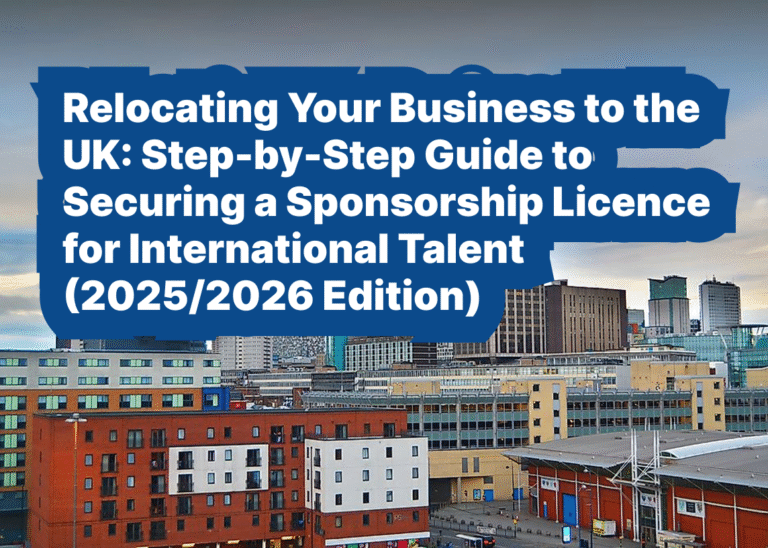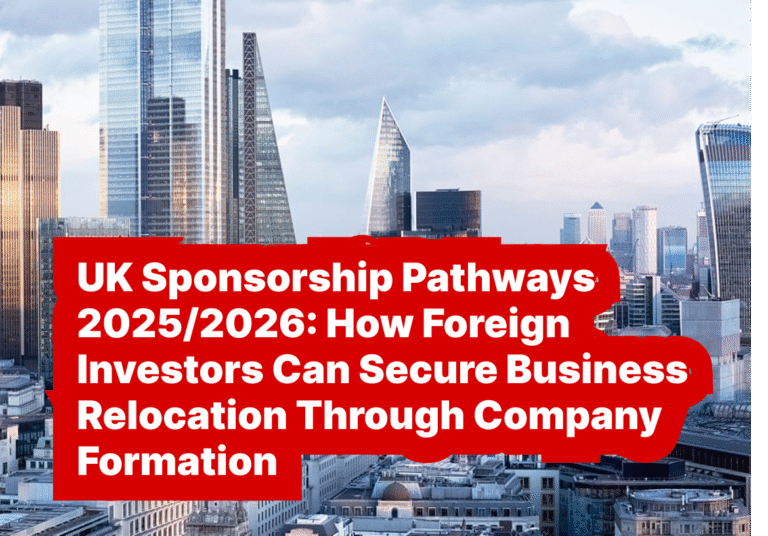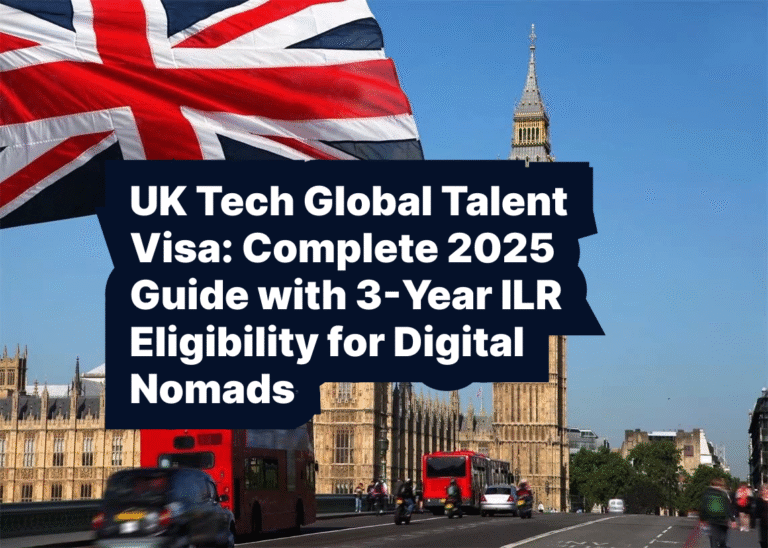Navigating the UK immigration system can be complex, particularly when trying to understand the relationship between skilled visas and employer sponsorship. Many prospective immigrants and employers struggle to grasp the fundamental differences between these interconnected but distinct concepts. This comprehensive guide will clarify the distinctions, explain how they work together, and provide essential information for both job seekers and employers in 2025.
The confusion often arises because skilled visas and sponsorship are intimately linked – you cannot obtain most skilled work visas without sponsorship, yet they represent different aspects of the immigration process. Understanding these differences is crucial for anyone planning to work in the UK or hire international talent.
Understanding UK Skilled Visas: The Foundation
A UK Skilled Visa, officially known as the Skilled Worker Visa, is an immigration permission that allows qualified individuals to live and work in the United Kingdom. This visa replaced the former Tier 2 General work visa and is designed for individuals who have been offered a skilled job with a UK employer. The visa itself is the legal document and status that grants permission to enter and remain in the UK for work purposes.
The Skilled Worker Visa operates under a points-based system where applicants must score at least 70 points across various criteria. These include having a job offer from an approved sponsor (20 points), the job being at an appropriate skill level (20 points), and demonstrating English language proficiency (10 points). The remaining points typically come from salary levels, with the general salary threshold now set at £41,700 as of 22 July 2025.
This visa allows holders to work for their sponsoring employer, bring dependents to the UK, and apply for settlement after five years of continuous residence. The visa can be granted for up to five years initially, with the possibility of extension. Importantly, the visa ties the holder to their sponsoring employer, though switching employers is possible under certain circumstances.
The Skilled Worker Visa represents a significant commitment from both the applicant and the UK government. It provides a clear pathway to settlement and potential citizenship, making it one of the most attractive work visa options available. However, obtaining this visa requires meeting specific criteria and having employer support through the sponsorship system.
What is UK Employer Sponsorship?
UK employer sponsorship is the process by which approved UK employers support foreign workers’ visa applications by vouching for their employment and meeting specific regulatory requirements. Employers must be approved sponsors before they can hire foreign workers, and these approved employers are responsible for sponsoring individuals to come to or stay in the UK.
Sponsorship is not a visa itself but rather the mechanism that enables visa applications. It represents the employer’s formal commitment to hire the foreign worker and comply with ongoing immigration responsibilities. The sponsorship system ensures that only legitimate employers can hire foreign workers and that proper oversight exists throughout the employment relationship.
Once an organisation acquires a sponsor licence, they become registered with the Home Office as a sponsor and can begin to issue Certificates of Sponsorship (CoS) to skilled non-UK staff. This certificate is the key document that links the employer’s sponsorship commitment to the individual’s visa application.
The sponsorship system serves multiple purposes: it protects the UK labour market by ensuring only genuine job offers exist, provides oversight of foreign workers’ activities, and creates accountability for employers who hire international talent. Without sponsorship, most foreign workers cannot obtain permission to work in the UK, making this system the gateway to legal employment for non-UK nationals.
Sponsorship involves ongoing responsibilities that extend throughout the employment relationship. Sponsors must report changes in employees’ circumstances, maintain proper records, and ensure compliance with visa conditions. This creates a partnership between the employer and the immigration system that continues long after the initial visa approval.
The Sponsor Licence: The Employer’s Permission
Before any employer can sponsor foreign workers, they must obtain a sponsor licence from the UK Home Office. This licence is the employer’s permission to participate in the sponsorship system and is entirely separate from any individual visa application. Without a sponsor licence, an employer cannot lawfully employ a non-UK national in most skilled or temporary work routes.
The sponsor licence application process requires employers to demonstrate they are legitimate businesses with genuine need for international talent. This involves providing evidence of business operations, financial standing, and compliance systems. The Home Office assesses whether the organisation can meet the responsibilities of sponsorship before granting the licence.
There are different types of sponsor licences depending on the category of workers an employer wishes to sponsor. The Worker licence covers Skilled Worker visas, while the Temporary Worker licence covers seasonal workers and other temporary categories. Some employers may need multiple licence types depending on their recruitment needs.
Sponsor licences were previously valid for four years and required renewal, but the requirement to renew sponsor licences every four years is being abolished from April 2024 for most categories. This change reduces administrative burden for established sponsors while maintaining compliance oversight.
The licence system creates a tiered approach to immigration control. Only approved organisations can participate in sponsorship, ensuring that the system maintains integrity while providing flexibility for legitimate business needs. This pre-approval process helps streamline individual visa applications while maintaining proper oversight of the sponsorship system.
Certificate of Sponsorship: The Bridge Between Sponsorship and Visas
The Certificate of Sponsorship (CoS) is the crucial document that connects employer sponsorship to individual visa applications. Employers must assign a Certificate of Sponsorship to each foreign worker as part of the application process. This certificate contains specific information about the job offer, salary, and the sponsored individual.
Each CoS is unique to a specific job and individual. It includes details such as the job title, salary, start date, and the applicant’s personal information. The CoS serves as the employer’s formal confirmation that they wish to sponsor the individual for the specific role. Without a valid CoS, a Skilled Worker Visa application cannot proceed.
There are two types of Certificates of Sponsorship: restricted and unrestricted. Restricted CoS are subject to annual quotas and are typically used for longer-term positions, while unrestricted CoS have no annual limits but are generally for shorter-term or specific categories of roles. The type of CoS required depends on the specific circumstances of the job and the applicant.
The CoS system allows the Home Office to track and monitor sponsorship arrangements. Each certificate creates a direct link between the employer’s sponsorship commitment and the individual’s visa application. This traceability helps ensure that the sponsorship system operates effectively and that both employers and employees meet their respective obligations.
Employers pay fees for each CoS they issue, creating a financial commitment to the sponsorship process. This fee structure encourages employers to carefully consider their sponsorship decisions and ensures that only genuine job offers result in visa applications.
Key Differences: Visa vs. Sponsorship
The fundamental difference between a UK Skilled Visa and sponsorship lies in their nature and purpose. The visa is the legal permission granted to an individual to enter and remain in the UK for work purposes. Sponsorship is the employer’s commitment and process that enables the visa application. One cannot exist without the other in the current system.
The visa belongs to the individual applicant and grants them specific rights and obligations within the UK. These include the right to work for the sponsoring employer, bring dependents, and eventually apply for settlement. The visa has a specific validity period and contains conditions that the holder must observe.
Sponsorship, conversely, represents the employer’s role and responsibilities in the immigration process. It includes obtaining the sponsor licence, issuing Certificates of Sponsorship, and maintaining ongoing compliance throughout the employment relationship. Sponsorship obligations continue as long as the employer has sponsored workers.
The application processes also differ significantly. Visa applications are submitted by individuals (or their representatives) and focus on meeting personal eligibility criteria such as English language proficiency, qualifications, and financial requirements. Sponsorship involves organisational applications where employers demonstrate business legitimacy and compliance capabilities.
Financial responsibilities are distributed differently between visas and sponsorship. Visa applicants pay application fees, healthcare surcharges, and meet maintenance requirements. Sponsors pay licence fees, skills charges, and CoS fees. These separate cost structures reflect the different roles each party plays in the immigration system.
The timeframes involved also vary. Visa applications typically take 3-8 weeks to process, while sponsor licence applications can take 6-8 weeks or longer for first-time applicants. The sponsorship relationship continues throughout the employment period, while visas have fixed validity periods requiring renewal or extension.
Recent Changes Affecting Both Visas and Sponsorship in 2025
The UK immigration system has undergone significant changes in 2025 that affect both skilled visas and sponsorship arrangements. An initial reduction to the list of jobs eligible for Skilled Worker visa sponsorship took effect on 22 July 2025, limiting the occupations for which employers can sponsor workers.
From July 2025, Skilled Workers can generally only be sponsored for graduate level jobs, except where the job is on the Immigration Salary List or Temporary Shortage List. This represents a significant shift toward higher-skilled immigration and affects which positions employers can use for sponsorship.
Salary thresholds have also increased substantially. Most Skilled Worker visa applicants must now meet a minimum salary of £38,700, an 82% jump from the current threshold of £26,200. These increases affect both the sponsorship requirements employers must meet and the visa eligibility criteria for applicants.
The changes also include specific provisions for different categories of workers. PhD holders continue to benefit from reduced thresholds, with applicants with relevant PhDs facing a threshold of £34,830 and those with STEM-related PhDs requiring £30,960. These graduated thresholds recognize the value of highly qualified applicants while maintaining overall restrictions.
New care worker recruitment requirements apply to any Certificate of Sponsorship assigned on or after 9 April 2025, demonstrating how changes affect specific sectors and sponsorship practices. These sector-specific modifications show how the system adapts to address particular labour market needs while maintaining overall control.
The Application Process: How Visas and Sponsorship Work Together
The practical relationship between skilled visas and sponsorship becomes clear when examining the application process. The journey typically begins when an employer identifies a need for international talent and decides to pursue sponsorship. This leads to obtaining a sponsor licence if they don’t already have one.
Once licensed, the employer can recruit international candidates and, upon making a job offer, issue a Certificate of Sponsorship. This CoS then enables the prospective employee to apply for a Skilled Worker Visa. The timing and coordination between these steps is crucial for successful outcomes.
The employer’s role during the visa application process involves providing supporting information and maintaining the validity of the CoS. If the employer withdraws the job offer or the CoS becomes invalid, the visa application will typically fail. This demonstrates the interdependent nature of sponsorship and visa applications.
From the applicant’s perspective, securing sponsorship is often the most challenging part of obtaining a Skilled Worker Visa. Meeting the personal eligibility criteria is typically straightforward for qualified candidates, but finding an employer willing and able to sponsor can be difficult, especially with recent changes limiting eligible occupations.
The application process also involves coordination of documentation and timing. Employers must provide accurate information for the CoS, while applicants must demonstrate they meet all visa requirements. Any discrepancies between the sponsorship information and visa application can lead to delays or refusals.
Rights and Responsibilities: Different Roles, Different Obligations
The rights and responsibilities associated with skilled visas and sponsorship are distinctly different, reflecting the separate roles each party plays. Visa holders have rights to live and work in the UK within the conditions of their visa, but they also have obligations to comply with immigration requirements and report changes in circumstances.
Sponsored workers must work for their sponsoring employer and cannot generally change jobs without obtaining a new CoS or following specific switching procedures. They must maintain the conditions under which their visa was granted, including salary levels and job descriptions. Failure to meet these obligations can result in visa curtailment or future refusal.
Employers with sponsor licences have extensive ongoing responsibilities that extend far beyond simply offering employment. They must maintain accurate records of sponsored workers, report changes in circumstances to the Home Office within specified timeframes, and ensure that sponsored workers comply with their visa conditions.
Sponsors must also conduct right to work checks, maintain HR systems that can track sponsored employees, and respond to Home Office queries about their sponsored workers. The compliance burden is significant and requires dedicated resources and attention to detail.
The consequences of non-compliance differ for each party. Visa holders who breach their conditions may face immigration enforcement action, visa cancellation, or future application refusals. Sponsors who fail to meet their obligations may face licence suspension or revocation, preventing them from hiring any international workers.
Financial Implications: Cost Distribution Between Parties
The financial aspects of skilled visas and sponsorship involve different cost structures for each party. Visa applicants bear the direct costs of their applications, including visa fees, healthcare surcharges, and maintenance requirements. These costs can total several thousand pounds for a single applicant and significantly more for those with dependents.
Sponsors face their own substantial costs, including sponsor licence fees, immigration skills charges, and Certificate of Sponsorship fees. The Immigration Skills Charge alone represents a significant ongoing expense, charged annually for each sponsored worker. These costs must be factored into hiring decisions and budget planning.
Some costs may be shared or negotiated between employers and employees. While the Home Office prohibits certain practices, such as requiring employees to pay immigration skills charges, many aspects of relocation and visa costs can be addressed through employment negotiations and relocation packages.
The total cost of bringing an international worker to the UK through sponsorship can easily reach £10,000-15,000 when combining all parties’ expenses. This significant investment reflects the commitment required from both employers and employees to make international recruitment successful.
Understanding these cost implications is crucial for both parties when considering skilled visa and sponsorship arrangements. Proper financial planning and clear agreements about cost responsibility help ensure successful outcomes and avoid disputes during the process.
Alternative Visa Routes and Their Relationship to Sponsorship
While the Skilled Worker Visa requires sponsorship, other UK work visas have different relationships with employer sponsorship. The Global Talent Visa, for example, does not require sponsorship but instead relies on endorsement from approved bodies in specific fields. This creates an alternative pathway for highly skilled individuals without employer dependency.
The Health and Care Worker Visa requires sponsorship but offers more favorable terms, including exemption from the Immigration Health Surcharge. This demonstrates how different visa categories can have varying sponsorship requirements while serving specific policy objectives.
Some visa routes, such as the High Potential Individual Visa, allow individuals to work without sponsorship for a limited period. However, transitioning to longer-term residence typically requires obtaining sponsored employment, showing how different visa types can work together in immigration planning.
Understanding these alternative routes helps both employers and prospective employees consider their options and develop appropriate immigration strategies. While sponsorship-dependent visas remain the primary route for most international workers, alternatives exist for those who qualify.
The relationship between different visa types and sponsorship requirements reflects the UK’s approach to managing different categories of international talent while maintaining appropriate controls and oversight of the immigration system.
Future Trends and Implications
The UK immigration system continues to evolve, with implications for both skilled visas and sponsorship arrangements. Recent changes suggest a trend toward higher skill requirements and increased selectivity in the categories of workers who can be sponsored.
The emphasis on graduate-level positions and increased salary thresholds indicates that future changes may further restrict access to skilled work visas. This could make sponsorship more valuable and competitive, potentially leading to changes in how employers approach international recruitment.
Technology and digitalization are also affecting both visa applications and sponsorship compliance. Online systems and digital documentation are becoming standard, potentially streamlining processes while maintaining necessary oversight and security.
The post-Brexit immigration landscape continues to develop, with the skilled visa and sponsorship system serving as key tools for managing international talent flows. Understanding these trends helps stakeholders prepare for future changes and adapt their strategies accordingly.
Both employers and prospective visa applicants benefit from staying informed about ongoing developments and considering how changes might affect their circumstances and planning.
Practical Guidance for Employers and Applicants
For employers considering sponsorship, the first step involves honestly assessing whether international recruitment is necessary and whether the organisation can meet ongoing sponsorship obligations. This includes evaluating compliance capabilities, financial resources, and genuine business need for international talent.
Prospective visa applicants should focus on understanding their eligibility for different visa routes while actively seeking employers who are licensed sponsors. Building qualifications and experience that meet current and anticipated requirements increases the likelihood of finding sponsorship opportunities.
Both parties benefit from professional advice when navigating the sponsorship and visa systems. The complexity and consequences of errors make expert guidance valuable, particularly for first-time participants in the system.
Documentation and record-keeping are crucial for both sponsors and visa holders. Maintaining accurate records and responding promptly to Home Office requirements helps ensure ongoing compliance and successful outcomes.
Clear communication between employers and sponsored workers throughout the process helps avoid misunderstandings and ensures that both parties meet their respective obligations effectively.
Conclusion: Understanding the Partnership
The relationship between UK skilled visas and employer sponsorship represents a partnership between individuals seeking to work in the UK and employers needing international talent. While these are distinct concepts with separate requirements and responsibilities, they are inextricably linked in the current immigration system.
Understanding the differences between visas and sponsorship helps all parties appreciate their roles and obligations. The visa provides the individual with legal permission to work in the UK, while sponsorship provides the employer framework that makes this possible. Neither can function without the other in most skilled work scenarios.
Recent changes to the system emphasize the importance of staying informed about evolving requirements and adapting strategies accordingly. The trend toward higher skills and increased selectivity affects both sponsorship decisions and visa applications.
Success in navigating this system requires careful planning, attention to detail, and ongoing compliance with requirements. Both employers and individuals benefit from understanding their respective roles and working together to achieve successful outcomes.
The skilled visa and sponsorship system will continue to evolve as the UK balances its need for international talent with immigration control objectives. Understanding these fundamental concepts and their relationship provides the foundation for successful participation in this important pathway to UK employment and residence.







